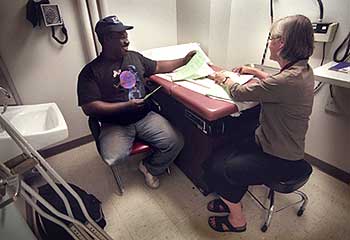 |
|||||||||
|
Outreach |
|
Program Has Grown Significantly Since Its Establishment
Twenty years ago the Seattle Pioneer Square Clinic consisted of one physician working out of an automobile. Now it’s a downtown Seattle community institution. The clinic is located on Third Avenue in a building situated between $450,000 lofts and subsidized housing for recovering addicts. The decline of the dotcoms and general economic slowdown have created a greater need for the clinic, especially in a time of hospital mergers and decreased governmental health-care subsidies.
“Pioneer Square has traditionally been a safety-net area for people who struggle with poverty or lack affordable housing,” said Dr. Nancy Sugg, associate professor of medicine and Pioneer Square Clinic director. “We’ve done a good job serving the downtown sector: homeless, low-income residents of Pioneer Square or other people in the community, but now we’re seeing more lower income people from places as far away as Auburn and Tacoma.”
 |
At the Seattle Pioneer Square Clinic, a patient goes over his follow-up care plans with Dr. Nancy Sugg. The clinic serves the diverse population of downtown Seattle, often seeing low-income residents of the neighborhood as well as from other western Washington cities. |
Sugg estimated that more than 70 percent of the clinic patients are men and almost all are below poverty level. The average patient age is 40, but the demographics are changing. According to Sugg, the clinic is starting to see a decline in 55- to 60-year-old chronic alcoholics and an increase in the number of youths on hard drugs.
Only 25 percent of the clinic’s patients receive Medicaid and 15 percent have Medicare. The majority of the patients have no third-party payer. County and state grants for the homeless and Harborview Medical Center's sliding scale payment plan help the clinic stay in business while serving people who don’t have sufficient financial resources.
The challenge for health-care workers at the Pioneer Square Clinic is to juggle good medicine with the socioeconomic reality of their patients. For instance, a diabetic homeless person, who doesn’t have much control over what food is available to him, may receive nutritional information at the clinic. The on-site nutritionist will help the patient figure out where he can go to get more than one meal a day and how to make good diet choices.
“If a pancakes and bacon breakfast is offered at the shelter, then the patient eats that or eats nothing, so we talk to him about portions or choosing margarine instead of butter,” said Sugg. “Education is important, especially for the intermittently homeless, so when the person gets into a better situation, he can help himself.”
|
After visiting the clinic, a patient heads back out into Pioneer Square. Along with treating their physical symptoms, the clinic emphasizes preventive care and educates patients on a variety of topics ranging from proper nutrition to community resources. |
 |
Other successful efforts include directly observed therapy, in which the patient comes in regularly Monday through Friday in order to insure medication compliance or for a shot of insulin. This watchfulness prevents the patients from being admitted to a hospital time and again.
To remedy no-shows for follow-up appointments, the clinic advises some continuity patients to come in after three weeks and then make an appointment for some time in the next 48 hours. The clinic staggers its continuity patient hours and tries to always have openings available.
“This system offers better access for my patients who live day-to-day and organize their lives only 24 hours at a time,” explained Sugg. “We’ve found that people who never kept an appointment in the past would be making these same-day appointments and keeping them. Some patients have even called to say they were running late.”
UW School of Medicine residents have the option of completing a continuity-care rotation at the clinic. The nature of the clinic population—patients with mental illness and diabetes or chronic obstructive pulmonary disease and substance abuse—is a challenge. Many members of the permanent staff, which totals 25, are five- to 10-year veterans of the Pioneer Square clinic.
“This is not a typical adult medicine clinic,” said Sugg. “People don’t work at this clinic unless they enjoy working with our patients.”
|
| UW AMC Medical Center | UW School of Medicine | Harborview | UW MC | Search UW AMC | UW Home | Contact Us | ©2001-2002, University of Washington Academic Medical Center. All rights reserved. Please honor our copyrights. |
|